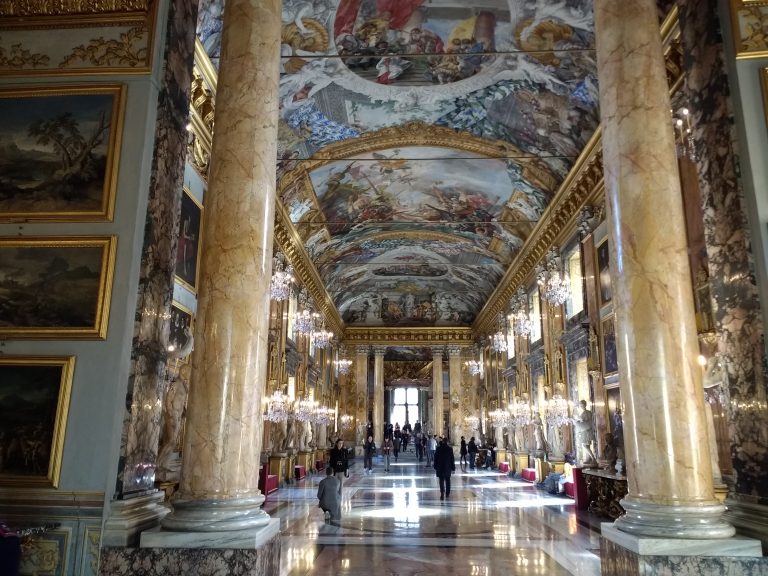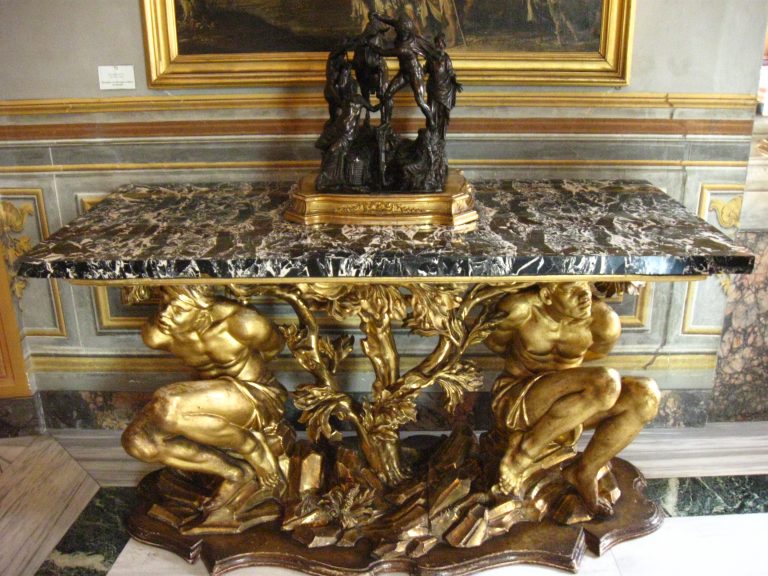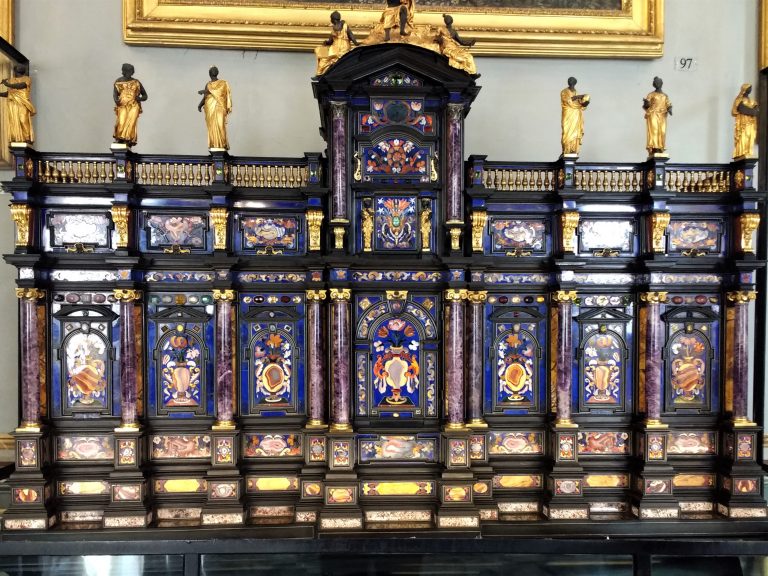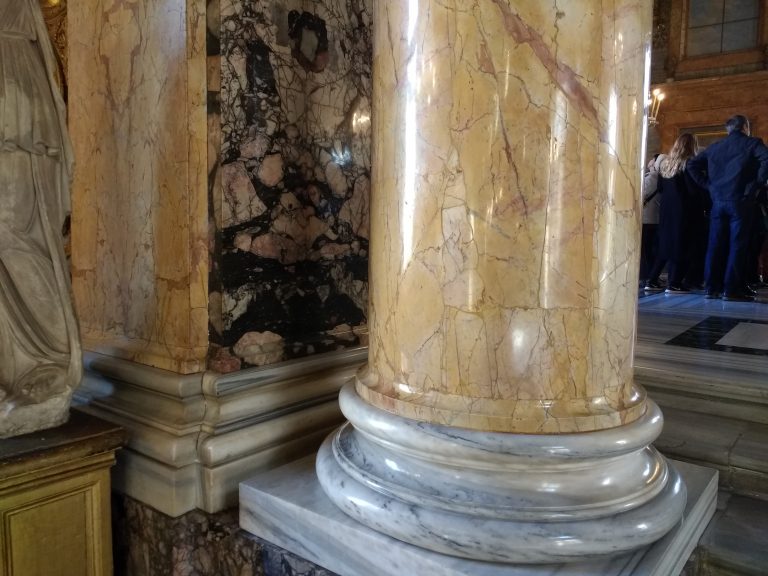Chapter 4: Palaces and Representations.
By the 1500s the Italian city-states, grown wealthy through trade and commerce, were providing new models of courtly life. Humanism and the lessons of the Renaissance had pointed the way towards a re-evaluation of scholarship and the arts, and voyages of discovery in the eastern hemisphere were inspiring new branches of scientific enquiry. Royal residences were evolving from military strongholds into centres of learning and culture, and for a short period cities like Florence, Mantua and Venice became the arbiters of architectural and artistic taste throughout Europe. In the case of Florence, this pre-eminence allowed the city to punch well above its military and diplomatic weight, enabling the Medici to marry into the Habsburg, Lorraine and Valois dynasties, as well as providing two of the century’s popes.
Where the Italians led the other European courts followed. In this changing world it was no longer sufficient for a ruler to be successful in battle (though it was still expected of him in the last resort). He also had to show his credentials through his learning, his collections of art and rare artefacts, and through an ongoing display of magnificence and ceremony at court. Throughout Europe formal etiquette and its correct observance were evolving into an essential aspect of the exercise of political power:
‘Ceremony is nothing in itself, yet it doth everything, for what is a King more than a subject, except for ceremony and order? When that fails him he is ruined. The cloth of estates, the distance people are with you, great officers, drums, heralds, trumpeters, marshal’s men making room and crying, “now the King comes”. Even the wisest, though he knew it and was accustomed to it, shall shake off his wisdom and shake for fear of it. You cannot put upon you too much King.’
(advice given to King Charles II by his tutor Henry Cavendish, Duke of Newcastle, just before the English Restoration (1660); it could have applied to any European ruler from the late sixteenth century onward.
The growth and implementation of complex systems of court procedure placed huge demands on the size and function of princely residences, and during the 17th century Baroque styles of architecture and decoration arose to meet the challenge. Grand entrance halls led to imposing staircases, and landings to long suites of adjoining rooms. These apartments and enfilades allowed a royal household to precisely calibrate the status of a visiting dignitary by the position of the room in which he or she was housed or obliged to await an audience; the closer they were to the person of the Prince, the higher their status.
Similar rules applied to the various levels at which encounters took place on a staircase. Only for someone of his own status or higher would a ruler descend to the bottom stair to greet a visitor. Seating arrangements at state banquets and festivities were subject to equally strict and carefully recorded formulas, requiring grand dining chambers, often with a raised dais for the prince and his most favoured guests and another for his musicians and actors.
There were variations between different lands. Rank and precedence were most keenly felt in the German states, whereas in Louis XIV’s France things were simplified by that fact that everyone was considered equal under the King. Such differences had a direct bearing on how palaces were laid out and designed; but whatever the specifics, these enfilades, grand staircases, picture galleries and courtyards were essential aspects of princely representation.
Rulers responded by abandoning or remodelling their medieval fortresses (which advances in modern artillery had rendered militarily obsolete), in favour of urban palaces and country estates. Building in the new style was ruinously expensive, but alongside warfare, hunting and patronage of the arts and sciences, it was one of the few activities considered appropriate for a prince; in early modern Europe royal extravagance was considered a duty rather than a vice.
Grand architecture requires grand materials and furnishings. For those who could afford it, coloured marble now became the material of choice for internal architecture: columns, door casements, chimney pieces, floors and wall panels. On the one hand marble was associated with the imperial – and eternal – values of Ancient Rome (see Section 1); on the other, the artistic designers who knew best how to work with it were fashionable Italian or Italian-trained architects and artists who had already been employed at the most prestigious Italian courts, and might be persuaded to work their magic elsewhere. The rooms that were fitted out with these architectural displays of marble were also furnished with rare marble and Pietre Dure table tops, display cabinets, treasure chests, and all the smaller glyptic objects of princely virtù that were given and received as diplomatic gifts.
For reasons that were usually economic or geographical, some European courts – Bavaria was a case in question – did not have access to the types of rare and costly marble that were considered appropriate to a ruler’s dignity, at least not in the quantities required. If someone could come up with a truly effective imitation, an ‘artificialia’ to use the expression of the day, the way to its exploitation would be wide-open.
Different uses of coloured marble in the Picture Gallery of the Palazzo Colonna, Rome. (2nd Half 17th Century) Click on images to enlarge.
References: Newcastle’s advice to Charles II, ed.Thomas P. Slaughter, London 1984 – Quoted by Jenny Uglow in her lecture of 10.06.09 The Restoration: Triumph or Failure (in the London Library Magazine Autumn 2009 Issue 5 p.29)
Alastair Laing: Part IV Central and Eastern Europe in Baroque and Rococo, Architecture and Decoration ed. Anthony Blunt, Ware1988 pp.167-176
S.J. Klingensmith, The Utility of Splendor Chicago and London 1993

Two Medici Popes: Pope Leo X (r. 1513-1521) and to his right the future Pope Clement VII (r. 1523-1534). Painting by Raphael, Uffizi Galleries, Florence. Photo Wikimedia Commons.
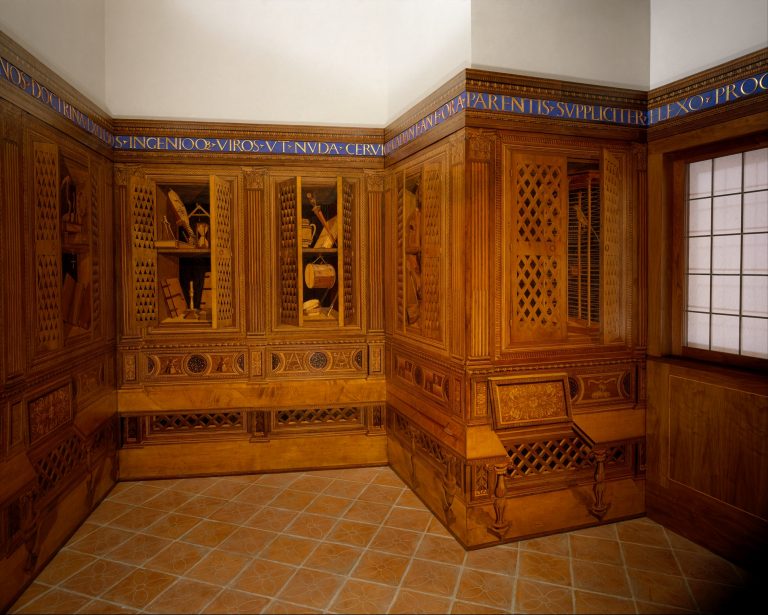
The intarsia-walled studiolo set up by Duke Federico da Montefeltro at Gubbio c. 1480. Private chambers such as this were used by Rennaissance rulers to store, study and show off unusual and precious possessions – and by inference their own knowledge and learning. They were the forerunners of the Wunderkammern (Chambers of Mysteries), which in turn led to the establishment of the first public museums. (Moved to and reassembled in the Metropolitan Museum of New York in 1939. Photo in the public domain under CC0 1.0)
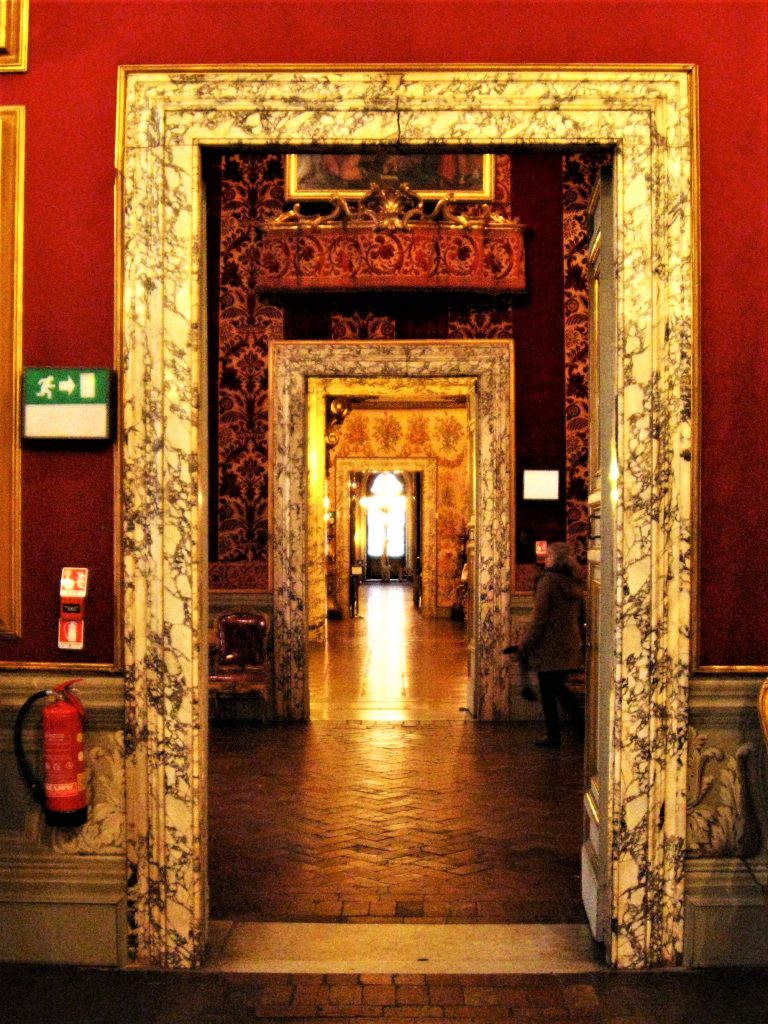
Marble door surrounds in an interconnecting suite of rooms. Palazzo Doria Pamphilj, Rome (16th – 18th Century)
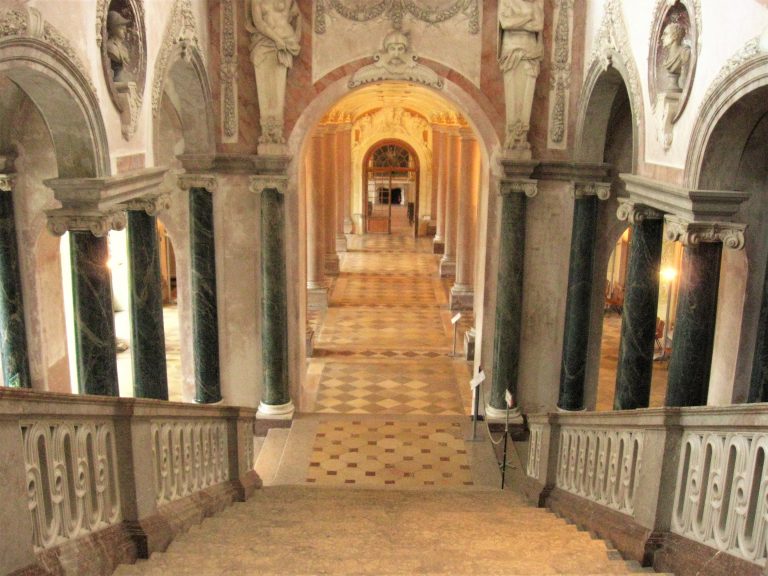
The Entrance Hall and Main Staircase of the Neues Schloss, Schleißheim, Bavaria (blt. 1701-1719).*
* © Bayerische Schlösserverwaltung, www.schloesser.bayern.de
Photo by Richard Feroze,
Chapter 4: Palaces and Representations.
By the 1500s the Italian city-states, grown wealthy through trade and commerce, were providing new models of courtly life. Humanism and the lessons of the Renaissance had pointed the way towards a re-evaluation of scholarship and the arts, and voyages of discovery in the eastern hemisphere were inspiring new branches of scientific enquiry. Royal residences were evolving from military strongholds into centres of learning and culture, and for a short period cities like Florence, Mantua and Venice became the arbiters of architectural and artistic taste throughout Europe. In the case of Florence, this pre-eminence allowed the city to punch well above its military and diplomatic weight, enabling the Medici to marry into the Habsburg, Lorraine and Valois dynasties, as well as providing two of the century’s popes.

Two Medici Popes: Pope Leo X (r. 1513-1521) and to his right the future Pope Clement VII (r. 1523-1534). Painting by Raphael, Uffizi Galleries, Florence. Photo Wikimedia Commons.
Where the Italians led the other European courts followed. In this changing world it was no longer sufficient for a ruler to be successful in battle (though it was still expected of him in the last resort). He also had to show his credentials through his learning, his collections of art and rare artefacts, and through an ongoing display of magnificence and ceremony at court.

The intarsia-walled studiolo set up by Duke Federico da Montefeltro at Gubbio c. 1480. Private chambers such as this were used by Rennaissance rulers to store, study and show off unusual and precious possessions – and by inference their own knowledge and learning. They were the forerunners of the Wunderkammern (Chambers of Mysteries), which in turn led to the establishment of the first public museums. (Moved to and reassembled in the Metropolitan Museum of New York in 1939. Photo in the public domain under CC0 1.0)
Throughout Europe formal etiquette and its correct observance were evolving into an essential aspect of the exercise of political power:
‘Ceremony is nothing in itself, yet it doth everything, for what is a King more than a subject, except for ceremony and order? When that fails him he is ruined. The cloth of estates, the distance people are with you, great officers, drums, heralds, trumpeters, marshal’s men making room and crying, “now the King comes”. Even the wisest, though he knew it and was accustomed to it, shall shake off his wisdom and shake for fear of it. You cannot put upon you too much King.’
(advice given to King Charles II by his tutor Henry Cavendish, Duke of Newcastle, just before the English Restoration (1660); it could have applied to any European ruler from the late sixteenth century onward.
The growth and implementation of complex systems of court procedure placed huge demands on the size and function of princely residences, and during the 17th century Baroque styles of architecture and decoration arose to meet the challenge. Grand entrance halls led to imposing staircases, and landings to long suites of adjoining rooms. These apartments and enfilades allowed a royal household to precisely calibrate the status of a visiting dignitary by the position of the room in which he or she was housed or obliged to await an audience; the closer they were to the person of the Prince, the higher their status.

Marble door surrounds in an interconnecting suite of rooms. Palazzo Doria Pamphilj, Rome (16th – 18th Century)
Similar rules applied to the various levels at which encounters took place on a staircase. Only for someone of his own status or higher would a ruler descend to the bottom stair to greet a visitor. Seating arrangements at state banquets and festivities were subject to equally strict and carefully recorded formulas, requiring grand dining chambers, often with a raised dais for the prince and his most favoured guests and another for his musicians and actors.
There were variations between different lands. Rank and precedence were most keenly felt in the German states, whereas in Louis XIV’s France things were simplified by that fact that everyone was considered equal under the King. Such differences had a direct bearing on how palaces were laid out and designed; but whatever the specifics, these enfilades, grand staircases, picture galleries and courtyards were essential aspects of princely representation.

The Entrance Hall and Main Staircase of the Neues Schloss, Schleißheim, Bavaria (blt. 1701-1719).*
Rulers responded by abandoning or remodelling their medieval fortresses (which advances in modern artillery had rendered militarily obsolete), in favour of urban palaces and country estates. Building in the new style was ruinously expensive, but alongside warfare, hunting and patronage of the arts and sciences, it was one of the few activities considered appropriate for a prince; in early modern Europe royal extravagance was considered a duty rather than a vice.
Grand architecture requires grand materials and furnishings. For those who could afford it, coloured marble now became the material of choice for internal architecture: columns, door casements, chimney pieces, floors and wall panels. On the one hand marble was associated with the imperial – and eternal – values of Ancient Rome (see Section 1); on the other, the artistic designers who knew best how to work with it were fashionable Italian or Italian-trained architects and artists who had already been employed at the most prestigious Italian courts, and might be persuaded to work their magic elsewhere. The rooms that were fitted out with these architectural displays of marble were also furnished with rare marble and Pietre Dure table tops, display cabinets, treasure chests, and all the smaller glyptic objects of princely virtù that were given and received as diplomatic gifts.
Different uses of coloured marble in the Picture Gallery of the Palazzo Colonna, Rome. (2nd Half 17th Century) Click on images to enlarge.
For reasons that were usually economic or geographical, some European courts – Bavaria was a case in question – did not have access to the types of rare and costly marble that were considered appropriate to a ruler’s dignity, at least not in the quantities required. If someone could come up with a truly effective imitation, an ‘artificialia’ to use the expression of the day, the way to its exploitation would be wide-open.
References: Newcastle’s advice to Charles II, ed.Thomas P. Slaughter, London 1984 – Quoted by Jenny Uglow in her lecture of 10.06.09 The Restoration: Triumph or Failure (in the London Library Magazine Autumn 2009 Issue 5 p.29)
Alastair Laing: Part IV Central and Eastern Europe in Baroque and Rococo, Architecture and Decoration ed. Anthony Blunt, Ware1988 pp.167-176
S.J. Klingensmith, The Utility of Splendor Chicago and London 1993
* © Bayerische Schlösserverwaltung, www.schloesser.bayern.de
Photo by Richard Feroze


